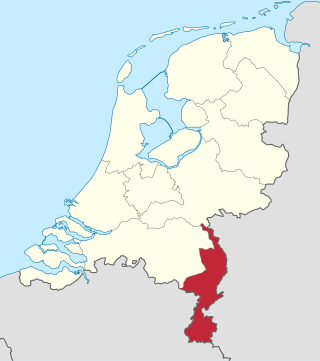
Limburg, also known as Dutch Limburg, is the southernmost of the twelve provinces of the Netherlands. It is bordered by Gelderland to the north and by North Brabant to its west. Its long eastern boundary forms the international border with the state of North Rhine-Westphalia in Germany. To the west is the international border with the similarly named Belgian province of Limburg, part of which is delineated by the river Meuse. To the south, Limburg is bordered by the Belgian province of Liège. The Vaalserberg is on the extreme southeastern point, marking the tripoint of the Netherlands, Germany and Belgium.
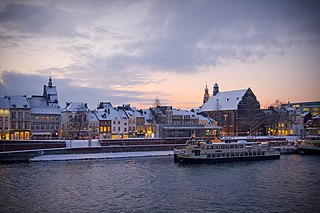
Maastricht is a city and a municipality in the southeastern Netherlands. It is the capital and largest city of the province of Limburg. Maastricht is located on both sides of the Meuse, at the point where the river is joined by the Jeker. Mount Saint Peter (Sint-Pietersberg) is largely situated within the city's municipal borders. Maastricht is adjacent to the border with Belgium and is part of the Meuse-Rhine Euroregion, an international metropolis with a population of about 3.9 million, which includes the nearby German and Belgian cities of Aachen, Liège, and Hasselt.

Zutphen is a city and municipality located in the province of Gelderland, Netherlands. It lies some 30 km (18.6 mi) northeast of Arnhem, on the eastern bank of the river IJssel at the point where it is joined by the Berkel. First mentioned in the 11th century, the place-name appears to mean "south fen". In 2005, the municipality of Zutphen was merged with the municipality of Warnsveld, retaining its name. In 2021, the municipality had a population of 48,111.

Limburg, also known as Belgian Limburg, is a province in Belgium. It is the easternmost of the five Dutch-speaking provinces that together form the Region of Flanders, which is one of the three main political and cultural sub-divisions of modern-day Belgium. As of January 2024, Limburg had a population of 0.9 million.

Brunssum is a municipality and a town in the province of Limburg in the Netherlands. The municipality of Brunssum has 27,670 residents as of 2021.

Heerlen is a city and a municipality in the southeast of the Netherlands. It is the third largest settlement proper in the province of Limburg. Measured as municipality, it is the fourth municipality in the province of Limburg.

Roermond is a city, municipality, and diocese in the Limburg province of the Netherlands. Roermond is a historically important town on the lower Roer on the east bank of the river Meuse. It received town rights in 1231. Roermond's town centre has become a designated conservation area.

Valkenburg aan de Geul is a municipality situated in the southeastern Dutch province of Limburg. The name refers to the central town in the municipality, Valkenburg, and the small river Geul passing through it.

Alphen aan den Rijn is a city and municipality in the western Netherlands, in the province of South Holland. The city is situated on the banks of the river Oude Rijn, where the river Gouwe branches off. The municipality had a population of 112,587 in 2021, and covers an area of 132.50 km2 (51.16 sq mi) of which 6.27 km2 (2.42 sq mi) is water.
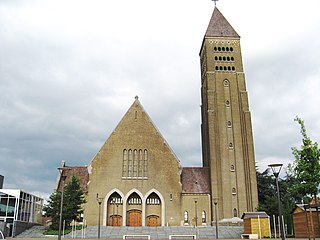
Genk is a city and municipality located in the Belgian province of Limburg near Hasselt. The municipality only comprises the town of Genk itself. It is one of the most important industrial towns in Flanders, located on the Albert Canal, between Antwerp and Liège.
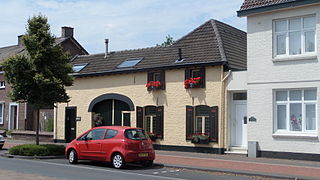
Geleen is a city in the southern part of the province of Limburg in the Netherlands. With 31,670 inhabitants in 2020, it is part of the municipality of Sittard-Geleen. Geleen is situated along the river Geleenbeek, a right tributary to the river Meuse. The Latin name for Geleenbeek is Glana, meaning "clear river". The town centre is situated at about 60 m above sea level.

Schin op Geul is a village in the Dutch province of Limburg. It is located in the municipality of Valkenburg aan de Geul, about 3 km southeast of the town of Valkenburg.
Hoen is a surname of Dutch or Norwegian origin. A variant form in Dutch is "'t Hoen". People with this surname include:

Heerlen is a railway station located in Heerlen, Netherlands.
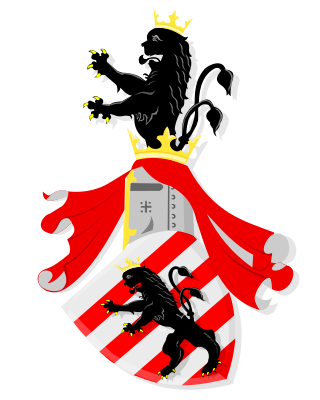
The House of Hoensbroeck is the name of an old aristocratic family with medieval origins in the town of Hoensbroek near Heerlen in Limburg, Netherlands. The family is part of Dutch and German nobility.
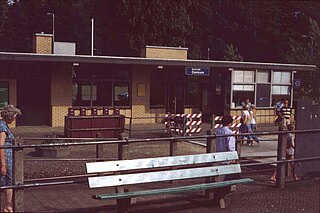
Kerkrade Centrum is a railway station in Kerkrade, Netherlands. The station was built in 1933 on the Schaesberg–Simpelveld railway and is the eastern terminus of the Heuvellandlijn (Maastricht–Kerkrade). However, as the Dutch Railways deemed it unprofitable at the time, the station did not see passenger services until 15 May 1949, when regular passenger services finally commenced on the Schaesberg–Simpelveld railway. Train services were operated by Veolia until 11 December 2016, when Arriva took over.
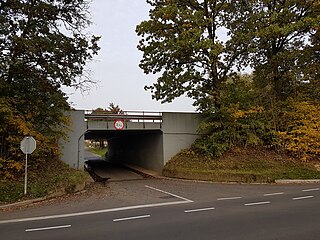
Laar is a hamlet in the Dutch province of Limburg. It is located just to the south of the town Beekdaelen. The A76 motorway divides the hamlet in two parts: the largest part, to the west, is part of the municipality of Nuth; the eastern part is in municipality Heerlen. There are no place name signs and it consist of about 10 houses.

Hoensbroek Castle or Gebrook Castle is one of the largest castles in the Netherlands. It is situated in Hoensbroek, a town in the province of Limburg. This imposing watercastle is known as 'the most lordly stronghold between Rhine and Meuse'. The oldest part of the castle, notably the tall round tower, dates from around 1360, when it was built by Herman Hoen, though a predecessor to the castle had already existed in the swamp the castle was located in. This so-called motte-and-bailey dated from around 1225. In 1250 a fortified manor was built on the location of the present castle. Because of its important strategical location in the Duchy of Brabant, located along important trading routes to Maastricht, Aachen and Cologne, the castle was expanded in several phases, becoming the largest stronghold between the Meuse and the Rhine rivers. It contains at least 67 halls, rooms and living quarters.

Jan Drummen was a Dutch architect.

Charles Hubert Eyck was a Dutch visual artist. Together with Henri Jonas and Joep Nicolas, he was a pioneer of the Limburg School.























